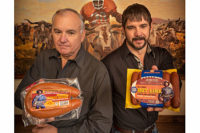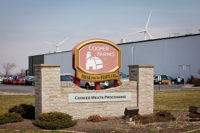Over the past year, Oklahoma City-based beef and sausage patty manufacturer Lopez Foods Inc. overhauled its company culture and management strategies to boost productivity and efficiency in its central plant in Oklahoma City. However, Lopez’s journey to success offers the perfect example of how even a successful processor needs to assess its own abilities and specialties before embarking upon initiatives that poke at the very core of the business.
Ed Sanchez, president and CEO of Lopez Foods, was pleased with the company’s success through its 15 years in business, but believed it was time for the business to take the next step. So he called upon Richard Lane, an assistant vice president of operations for Lopez Foods, for his thoughts on how it could move to a new level of production and efficiency in its Oklahoma City operations.
“We wanted to make, in Ed’s words, ‘a quantum leap,’ and really change the way the company would do business forever — really see a shift in how the company performs,” Lane explains.
Lane agreed, but he convinced Sanchez that the company should give it a shot on its own.
“We talked about consultants coming in and doing the same kind of process. And I said, ‘Gee, Ed, that’s a lot of money. I don’t know about that. I think we’ve got it under control. Let us work on it and see what we can do.’ We worked hard and buckled down.”
It was a valiant effort, Sanchez concludes, but it wasn’t exactly what he had envisioned in terms of growth and change.
“Twelve months later, we were sitting with some improvements,” Sanchez says. “But it really was not a quantum leap, and we were looking for a quantum leap. So, at the end of that period, we said, ‘Let’s take a risk and do this.’”
Proudfoot Consulting, with its North America offices in Atlanta, was subsequently called upon to partner with Lopez Foods, using its Co-Venture® strategy to increase the productivity and efficiency of the Oklahoma City operations.
“[Lopez Foods’] expertise is making the product they make,” says Dean Lampman, director of operations with Proudfoot. “Their expertise, nor any meat business’ expertise, is not in generating behavioral change that leads to a definitive financial benefit that leads to definitive step-level increases in performance.”
High hopes
From the start, high expectations were set for the partnership, and Lopez Foods made sure to keep its employees well-informed throughout the process, explains Dave Lopez, assistant vice president and STAR coordinator at Lopez Foods.“We were very open with everybody and had a bi-weekly newsletter that updated the associates,” he says. “We did a lot of what we call ‘brown papers,’ where we went through the different processes on brown paper on the wall.
“It took up the whole wall, and it was the process of, say, the beef department. We got everyone involved, got sticky [notes], and said, ‘Here’s the process ‘as-is,’ and we want to work on the ‘to-be’ — what’s it going to be?’”
Lane explains that a production worker on that particular process would pass by and could scratch something out and write down on a sticky note how the process really works.
Along with opening the lines of communication to the employees on the project, Lopez Foods was able to secure buy-in from its employees through a number of unique strategies and methods that Proudfoot brought to the partnership. Additionally, says Sanchez, the change was never designed to be something dictated from management down to the employees.
“Now, [employees] are participating in the decision-making process, and by them participating, it makes us all more efficient,” he explains. “The efficiencies were not picked arbitrarily — there were time and motion studies done, so it was very well-orchestrated.”
Employee input led to several changes in the project — including staffing requirements. Sanchez says employees were able to see inefficiencies in the process that they couldn’t see before, leading them to question the amount of manpower dedicated to some tasks.
“Things we thought would be a hard sell on the employees, they themselves have come up to us and said, ‘We can do this better,’ or ‘We don’t need five people here, we only need three,’” Sanchez adds.
Because of time-management analyses performed by employees and the Lopez-Proudfoot task forces, Lopez Foods was able to trim more than 20 positions from the plant. Lane explains that the data revealed by the task force assessments simply opened the company’s eyes to a staffing situation that was inefficient.
“[Employees] went out and, through this direct-observation process, realized, ‘We have a lot of fat out there,’ if you will,” Lane says. “What had happened was, we had tried to plan for our worst day. We had enough extras on hand, [because] we didn’t want to get caught in a situation where we’d say, ‘We can’t staff the lines today, I guess we won’t run full capacity.’ So we were able to dramatically reduce the number of extra people required.”
Sanchez says the inherent high-turnover problem brought on by staffing all those temps was hurting the company financially and methodically.
“That was where our high turnover was, among the temps,” he says. “The temps come in, and 90 days later, we can either hire them or they go back to the agency, so they’re only temporary for 90 days.
“The turnover for the permanent crew is below 30 percent, and for management, it’s below five percent, so people like to work here, which is a good thing.”
As Lopez Foods grows and attains more volume, Sanchez says, he expects more jobs will be created in the plant.
Taking it to the people
None of the changes that the Lopez Foods-Proudfoot task force made would have been possible without the top-notch assessments and teaching that Proudfoot engaged in upon walking in the door. Proudfoot, which Lampman says is “not in the advice business,” came in with the same strategy it follows with all its clients.“We don’t come in, provide suggestions and say, ‘Good luck with that’ and walk away,” he adds. “We’re in the implementation business — we execute what the project approach is.”
Furthermore, Proudfoot teaches and guides its clients through the process so that the client can continue to follow the new strategies and apply lessons learned to other areas. Proudfoot employees came in and not only assessed the daily activities of Lopez Foods’ managers and supervisors, but it also took the processor through the steps of formalizing its new culture and extending it beyond Proudfoot’s six-month engagement.
“Rather than this remaining a Proudfoot project or Proudfoot process, at their recommendation, we wanted to internalize it,” Lane says. “We went through a brainstorming session that was kind of a fun process, trying to come up with something appropriate that meant something to this process and that we could coin as our own.”
With that, the STAR Program was born. STAR stands for “Systems, Training, Actions, Results.”
Through the program, Lopez Foods has continued to assess its processes. But the heart of the program remains rooted in the systems and ideals infused during the Proudfoot engagement.
Today, Lopez Foods has complete control over the STAR Program and has found ways to build it further. Many of the additional strategies and tactics have worked well to keep employees engaged in the program and motivated to improve the processes in the plant.
“People asked if this was just going to be a weeklong, flavor of the week,” Lopez says. “But after four or five weeks of hitting the results and getting the solid numbers, people started to say, ‘OK, this is working.’”
It has worked so well, Lopez says, that the company has a “laundry list” of areas and processes to which it is prepared to apply the STAR Program. If the success of the program in the plant is any indication, employees elsewhere are likely to hop on board quickly.
One of the motivational tactics Lopez Foods has developed in the last six months has had a big impact across the plant. An Overall Equipment Efficiency (OEE) tracking system and board communicates to the entire company the big-picture targets it has for each of four key departments. The OEE formulaically takes into account throughput, up time and yield, and translates it into a percentage grade for the day.
When a department hits its target OEE for the day, it gets a green checkmark. If it misses its target, it gets a red mark. For every green checkmark registered during a quarter of the year, every single employee at the Oklahoma City facility gets $1.
“It got everyone to buy in and be engaged in the process, because they had a little bit of skin in the game now,” Lane says. Employees can earn up to $4 per day if all four departments hit their targets. It’s a cost, but Lane says it’s also a well-designed way to motivate and raise the bar on productivity.
“What’s kind of neat about it is, we’ve already gone through one three-month period, so we entered this three-month period after we tweaked the numbers a little bit and moved those performance numbers up, which drove the OEE number a little higher,” he explains. “So you ratchet it up a bit and try to keep it at this optimum target for your payout, and if they beat it, that’s great.”
Lopez agrees that paying out more than planned in those highly successful quarters is a win-win situation.
“It’s fun to give away the money,” he says. “That means we’re doing well; it’s a sign of success.”
Action!
During the process, Proudfoot analyzed employees’ use of time, specifically the balance between active and passive management and administrative duties.Daily time-use studies revealed a disconnect between actual active-management duties and how much time those supervisors believed they were actively managing their departments. The next step was to re-train the managers to be more active in their departments, Lane says.
“[Proudfoot] went out and did direct observations,” he adds. “I’m going to follow you around all day long and jot down what you do all day long. ... What it showed was that we needed to teach people how to actively manage, to be out there counseling, coaching, working with their people, training them, solving problems.”
Proudfoot brought in its People Solutions team for the task, which helped mold the mindset of the entire company, not just the managers who were being retrained. Furthermore, all employees and management were being weaned off old habits of using a wide variety of metrics to gauge performance and success on daily, weekly and monthly bases.
“Something I’d been trying to accomplish on my own with the help of my peers but struggled to do it, was to get everyone to use the same barometer to measure performance,” Lane says. “There are so many key performance indicators in our process, but someone’s looking at this, others are looking at that. What happened in the STAR process is that we got everybody on the same page, looking at the same key performance indicators not only on a daily basis, but on an hourly basis.”
Once the entire plant was on the same page in terms of metrics, Lopez could concentrate on creating new ways to communicate progress with employees. Short-interval Control (SIC) Boards, which are posted in every department across the plant, were developed to measure performance using these metrics on an hourly basis. Lane says SIC Boards have done wonders for on-floor morale and productivity.
“[In the past,] they work hard, they go home, they’re tired, and they’re not really sure if they had a good day or bad day,” he says. “So the other key piece that came out of this was the visibility of those key performance indicators to everybody.”
SIC Boards give employees hour-by-hour feedback, Lane says, because they’re out there in front of every person on the line. Employees know what they did that hour — if they were above or below their target — and respond to the boards and the knowledge of how they’re performing. Lane says it’s not unlike the panel on a treadmill, giving constant feedback and motivation.
“You see how many calories you’re burning, how many miles you have gone, how many watts you’ve generated, and it kind of motivates you on,” he says. “People say, ‘We can do this, we only have to go this much further and we’ll set a record.’”
Management also was trained to be more proactive than reactive in terms of problem-solving. Lane and Lopez meet with department managers every afternoon to assess performance and stay abreast of the solution strategies that are being enacted. Lane explains that the company’s managers have become more disciplined in focusing not on problems, but on doing root-cause analysis to avoid just putting a Band-Aid on the issue. Lopez sees the change in the way managers approach the daily meetings.
“You’re not going to come in there and explain what happened,” he says. “You’re going to have your answers ready and say, ‘Here’s what we did. Here’s the solution,’ versus telling us why we had this down time and this problem. That’s where people have changed their behavior is that they feel they’d better come prepared.”
After a year of battling through changes, Lopez Foods is now settled in and better-prepared to face the challenges of production with a different spin on strategies and corporate culture thanks to Proudfoot’s guidance. The quantum leap in corporate thinking allows Lopez Foods to better serve its current customers and deal with the growth that has spurred it along for the past decade and a half. Rather than go it alone, Lopez Foods wisely chose to partner with a consulting firm to learn how to be a more efficient, productive company with an engaged, continuously driven-to-improve workforce.
Proudfoot didn’t simply give Lopez Foods a roadmap to succeed with the STAR Program, but it helped teach Lopez how to navigate the roads. Lopez Foods was wise enough to learn and, as a result, gained the tools, systems and strategies necessary to “DIY” any future productivity initiatives and projects.






